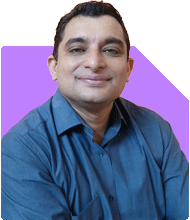Ramalingam Kalirajan |8292 Answers |Ask -Follow
Mutual Funds, Financial Planning Expert - Answered on May 23, 2024
He has an MBA in finance from the University of Madras and is a certified financial planner.
He is the director and chief financial planner at Holistic Investment, a Chennai-based firm that offers financial planning and wealth management advice.... more

Hi Sir, I am 58 years old retired person with monthly rental income around 90k . Have 2 children 26 and 19 , both not settled yet . I have 2.85 in bank savings and fds. I have my own house and other properties worth 9 cr only, I need your your advise to plan my savings to diversify better so that my savings can give me atleast 3 lac a month as returns. My Monthly expenses are 1 lac min. A month, Kindly Advise
Understanding Your Current Financial Situation
At 58 years old, you are enjoying a stable retirement with a monthly rental income of Rs. 90,000. Your financial portfolio includes bank savings and fixed deposits totaling Rs. 2.85 crores, alongside real estate properties valued at approximately Rs. 9 crores. Additionally, your monthly expenses stand at Rs. 1 lakh.
Financial Goals and Requirements
Your primary goal is to generate a monthly return of Rs. 3 lakhs from your savings to comfortably cover your expenses and potentially support your children. Given your substantial assets, it’s crucial to diversify your investments to achieve this goal while managing risks effectively.
Diversifying Your Investment Portfolio
To achieve a monthly return of Rs. 3 lakhs, we need to strategically diversify your savings. Here are the recommended steps:
1. Mutual Funds: Active Management for Higher Returns
Mutual funds are an excellent option for achieving higher returns. Actively managed funds are particularly beneficial because they can outperform index funds, especially during market fluctuations. Regular investments through a Certified Financial Planner (CFP) can provide tailored advice and continuous monitoring.
2. Fixed Deposits and Debt Funds: Stability and Security
While you already have Rs. 2.85 crores in bank savings and FDs, consider allocating a portion to debt funds. Debt funds offer better returns than traditional fixed deposits, with the added advantage of liquidity. They provide stability and can act as a safety net during market volatility.
3. Equity Mutual Funds: Long-term Growth
Equity mutual funds are essential for long-term growth. Given the diverse nature of these funds, they can provide substantial returns over time. Consider allocating a significant portion of your savings to diversified equity funds, focusing on sectors with high growth potential.
4. Balanced or Hybrid Funds: A Mix of Equity and Debt
Balanced or hybrid funds combine equity and debt, offering a balanced risk-reward profile. These funds are ideal for generating steady returns while mitigating risks. They are especially beneficial as you approach and enjoy retirement, providing both income and capital appreciation.
Generating Monthly Income
To achieve the desired monthly income of Rs. 3 lakhs, a diversified portfolio is essential. Here’s a structured approach:
1. Monthly Systematic Withdrawal Plan (SWP)
A Systematic Withdrawal Plan (SWP) from your mutual fund investments can provide a regular income stream. This approach ensures that you receive a steady income while your capital continues to grow. It’s a strategic way to meet your monthly expenses without eroding your principal investment.
2. Regular Monitoring and Rebalancing
Regular monitoring and rebalancing of your portfolio are crucial. Market conditions and your financial needs may change, necessitating adjustments to your investments. A Certified Financial Planner can help you review and rebalance your portfolio periodically, ensuring it aligns with your goals.
Addressing Your Children’s Future
Your children, aged 26 and 19, are not yet settled. Here’s how you can plan for their future:
1. Educational and Professional Support
Consider setting aside a portion of your investments for their education and professional development. Equity mutual funds can provide the necessary growth to support their long-term goals.
2. Emergency Fund
Maintain an emergency fund to cover unforeseen expenses related to your children. This fund should be easily accessible and invested in low-risk, highly liquid instruments like savings accounts or short-term debt funds.
Avoiding Specific Investment Pitfalls
1. Disadvantages of Index Funds
Index funds, while popular, often underperform during market downturns. They track the market and do not adapt to changing conditions. Actively managed funds, on the other hand, offer the expertise of fund managers who can navigate market complexities, potentially delivering higher returns.
2. Drawbacks of Direct Funds
Direct funds may seem cost-effective due to lower expense ratios. However, they lack the personalized guidance and continuous support provided by investing through a Certified Financial Planner. Regular funds, managed through a CFP, offer tailored advice, monitoring, and adjustments that are crucial for long-term success.
Final Thoughts and Encouragement
You have built a solid financial foundation through diligent savings and investments. By diversifying your portfolio and seeking professional guidance, you can achieve your goal of generating a monthly income of Rs. 3 lakhs. This strategy will not only secure your financial future but also provide support for your children as they find their footing.
Please continue to review and adjust your investments regularly, keeping your long-term objectives in mind. With careful planning and disciplined execution, you can enjoy a comfortable retirement and ensure your family’s well-being.
Best Regards,
K. Ramalingam, MBA, CFP
Chief Financial Planner
www.holisticinvestment.in
You may like to see similar questions and answers below
Ramalingam Kalirajan |8292 Answers |Ask -Follow
Mutual Funds, Financial Planning Expert - Answered on May 22, 2024
Ramalingam Kalirajan |8292 Answers |Ask -Follow
Mutual Funds, Financial Planning Expert - Answered on Jul 16, 2024
Ramalingam Kalirajan |8292 Answers |Ask -Follow
Mutual Funds, Financial Planning Expert - Answered on Jul 30, 2024
Dr Dipankar Dutta |1172 Answers |Ask -Follow
Tech Careers and Skill Development Expert - Answered on Apr 26, 2025
Dr Dipankar Dutta |1172 Answers |Ask -Follow
Tech Careers and Skill Development Expert - Answered on Apr 26, 2025
Radheshyam Zanwar |1572 Answers |Ask -Follow
MHT-CET, IIT-JEE, NEET-UG Expert - Answered on Apr 26, 2025
Dr Dipankar Dutta |1172 Answers |Ask -Follow
Tech Careers and Skill Development Expert - Answered on Apr 26, 2025
Dr Shakeeb Ahmed Khan |154 Answers |Ask -Follow
Physiotherapist - Answered on Apr 26, 2025
Mayank Chandel |2239 Answers |Ask -Follow
IIT-JEE, NEET-UG, SAT, CLAT, CA, CS Exam Expert - Answered on Apr 26, 2025
Mayank Chandel |2239 Answers |Ask -Follow
IIT-JEE, NEET-UG, SAT, CLAT, CA, CS Exam Expert - Answered on Apr 26, 2025
Prof Suvasish Mukhopadhyay |593 Answers |Ask -Follow
Career Counsellor - Answered on Apr 26, 2025
Prof Suvasish Mukhopadhyay |593 Answers |Ask -Follow
Career Counsellor - Answered on Apr 26, 2025
Prof Suvasish Mukhopadhyay |593 Answers |Ask -Follow
Career Counsellor - Answered on Apr 26, 2025





















